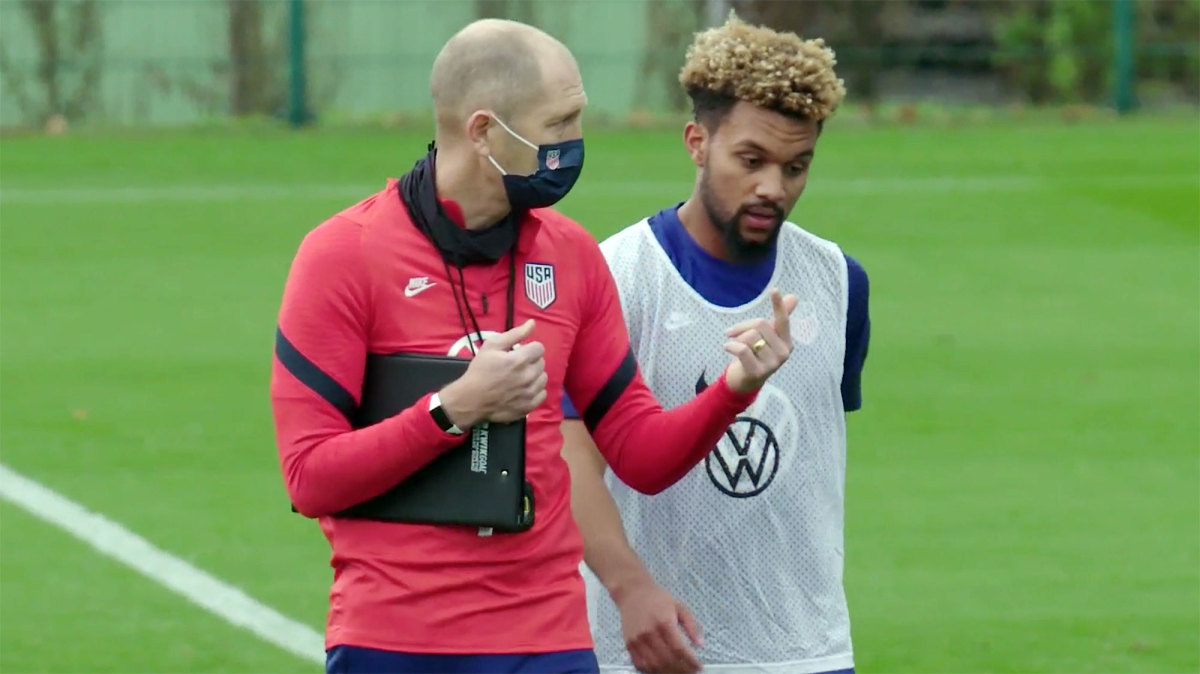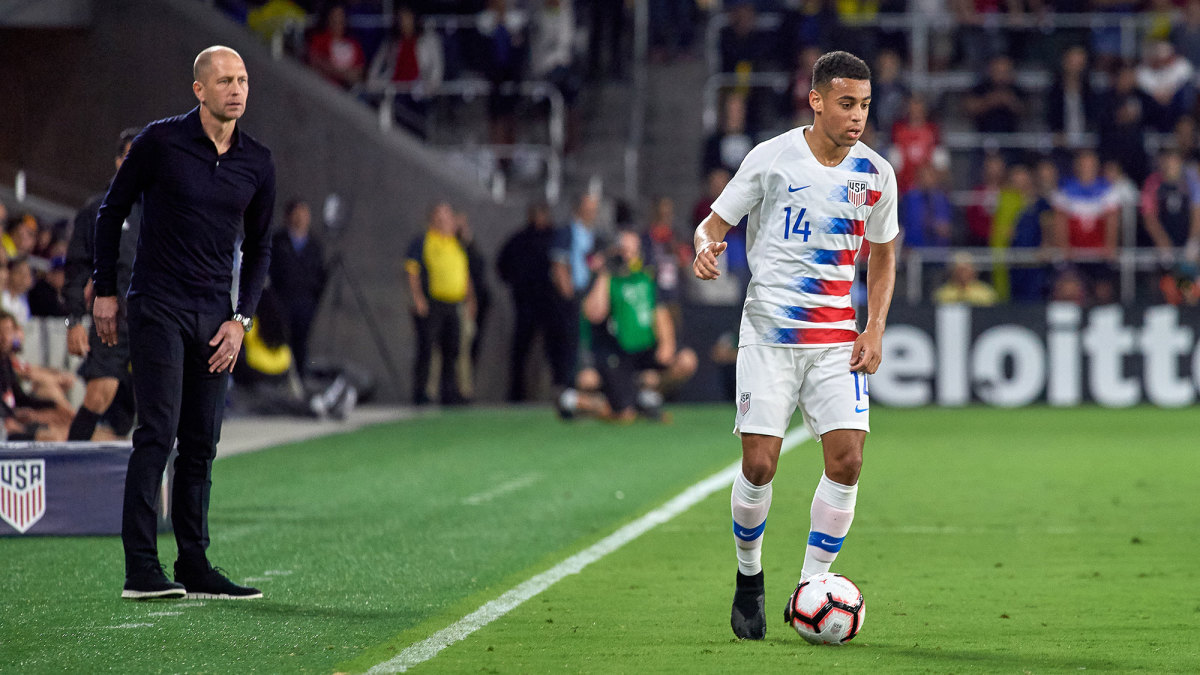The USMNT Picks Up the Pieces After a Long Time Away
You play to win the game, sure. But sometimes, the game(s) you’re trying to win aren’t necessarily being played that day.
The numbers on the scoreboard were rough—embarrassing, even. They read Mexico 3, USA 0 that day at MetLife Stadium in northern New Jersey. It was September 2019, and the U.S. national team had suffered its worst loss to El Tri in a decade. Mexico was stocked with first-choice stars that night and the USA’s lineup was a mixed bag. But excuses typically aren’t tolerated in rivalry games. So coming on the heels of a defeat in the Concacaf Gold Cup final, the result elicited frustration and criticism from fans.
USA coach Gregg Berhalter knew that was coming.
“I see where the narrative is going now,” he said at his postgame press conference.
But for Berhalter, there was more to the narrative than the scoreboard. There were other numbers—more granular, nuanced numbers—that were less about the outcome of one game than about his long-term goal of building a team that was more comfortable with the ball. Berhalter knew El Tri would press. So he challenged his team to play through it, to keep and rotate the ball and to find teammates in the spaces the pressing Mexicans vacated. When it failed, the Americans tried again. And when Berhalter looked at the postgame analytics—figures associated with possession, how many pass attempts and touches the USA had in certain areas of the field, etc.—he saw the foundation of a structure he was trying to build.
The scoreboard was important. Those other numbers were, too.
“It’s a delicate thing, because I know people want us to win. I understand that. I’m not foolish,” he told Sports Illustrated. “But we also have a process we have to go through. We have to do this if we want to get to where we want to get to.”
It’s a difficult thing to introduce a new generation of players to international soccer, to get them to play the game a bit differently than their U.S. predecessors—to “disorganize the opponent with the ball”—and to do it all during the very intermittent and fractured schedule that governs national teams even in normal times.
Berhalter had been a club coach. He’d been accustomed to immersing his players in daily details, building chemistry and partnerships and patterns through repetition and routine. Now he was trying to build a core and a system of play with only a few days of face time per month, at best. He felt it was time for the USA to play differently. He felt it was worth the effort.
“It’s the hardest thing in the world,” Christian Pulisic said moments after the Mexico game. “It’s hard to teach a real system and be very specific with it. It’s not easy.”
Pulisic continued, “Of course there’s frustration when you lose 3–0. There’s always frustrations. But we have a style of play that we’re setting out and we’re still trying to execute and obviously today we didn’t pull it off at all times. But there were a few good moments, and that’s all we can take from it and just try to continue to learn.”
Berhalter and the Americans ground out a 1–1 draw with Uruguay a few days later and then dispersed, as national teams do. And they’ve played only five games since—five games in 14 months. Thanks to the pandemic, there’s been almost no time to build on what was established last fall. Berhalter’s project was, at least superficially, put on extended pause. And during that time, even more young, talented Americans began knocking on the senior-team door. When the manager announced his 24-man team for this month’s long-awaited friendlies against Wales (Thursday) and Panama (Nov. 16), it included 10 uncapped players.

None of those players will have had the opportunity to work on those patterns and partnerships with their new U.S. teammates. Other, more seasoned (but still youthful) internationals are back together for the first time in a year. And not only do they have only a couple days to train fully before facing Wales in Swansea, they’re all quickly approaching a 2021 stretch in which the USA has a Gold Cup and the start of World Cup qualifying to negotiate.
Berhalter’s plan always was going to take time. And time has taken on new meaning in 2020.
Speaking to reporters from Wales on Monday, Berhalter said that despite the delays and time spent apart, he felt there was a core in place that has grasped the way he wants to play. Pulisic, midfielder Weston McKennie, defender Tim Ream and goalkeeper Zack Steffen all were capped at least 10 times last year, while John Brooks, Reggie Cannon, Sergiño Dest, Sebastian Lletget, Matt Miazga and Josh Sargent made multiple starts.
Just as crucially, time together doesn’t end when camps disperse. Berhalter and his staff stay in constant contact with their players, talking soccer and even going over footage of their club games. For those near the surface of the player pool, Berhalter’s system should be well understood by this point. He now feels it's time to deepen that pool, owing to the emergence of new talent and the busy year ahead.
“When we have our core together, I think it’s a team that’s made progress. I think now’s a great time to look at some new players, to look at some of the younger guys who’ve been doing a great job with their club teams. And so that’s what we’re using this camp for,” Berhalter said Monday.
“Admittedly, [building comfort and chemistry] is something I think about also,” he continued. “In this [Wales] game, it’s going to be probably six or seven guys that are on the field for the first time playing together. So it will be a new experience. But I think when you look at the core, and the players we were able to influence over the last 18 months, that’s definitely a group that is up to speed.”
There’s even the possibility of additional wrinkles, he revealed, as he looks to use the squad’s youth and athleticism to his advantage.
“It’s about taking advantage of the quality that we heave in the team, and what I mean is, are there times where we can be more aggressive pressing? I think I was very comfortable with a mid-block 4-4-2 before. We’ve talked about the transition from that into more of a 4-3-3 defending. There’s no secret on that, and it's based on the athletes that we have and the quality that we have,” he said.
“It won’t change much in terms of us wanting to control the ball. It won’t change much in terms of us wanting to use the ball to create goal-scoring opportunities, and we have guys that can do it. For me, it’s just adding another layer to our group.”
If there’s anyone who might feel like there’s considerable catch-up to do, it’s Tyler Adams. The 21-year-old New Yorker is certainly considered part of Berhalter’s core. He’s a rising star in defensive midfield at RB Leipzig and has big-game, UEFA Champions League experience. But Adams missed last year’s Gold Cup and Concacaf Nations League games with injuries and hasn’t played for the USA since March 2019. And he played then, in a friendly against Ecuador, as a right back.

But Adams explained that his work as a defensive midfielder in Leipzig and his frequent conversations with the U.S. coach leave him level with almost everyone else heading into this week.
“I would say everyone’s quite behind, because we’ve had eight months off to a pandemic. But other than that, it’s just about coming in and taking as much information in as possible,” Adams said.
Berhalter maintained steady contact with Adams during his injury layoff and the pandemic pause.
“He’s really helped me through a lot of different things, a lot of different variables. We’ve talked football and, you know, what my role in the team will be like,” Adams said. “He’s also been able to help me think about the game in a different way as well. He has a similar style to the way [Leipzig coach] Julian Nagelsmann plays, so my development under Julian has allowed me to make the understanding of my game evolve here as well. That’s been really good. [Berhalter] has a lot of bright ideas, and I’m just hoping we can now implement them in the game scenarios and just continue to progress.”
Training time isn’t the only time that Berhalter and staff can use to implement their system. They hold meetings with players, both individually and collectively, and had iPads filled with select video clips waiting for the players when they arrived. Time together may be brief, but it does seem to be immersive. The key will be building at the right rate toward next year, accepting scheduling quirks beyond their control and maintaining realistic expectations for a group featuring many new faces. World Cup qualifying kicks off next September. That’s when you really play to win.
“Moving forward, we obviously need to progress day by day,” Adams said. “It’s different when you have guys that played [Sunday]. They’ll only train twice before the first friendly and then we won’t be able to train that much time between this friendly and the next one [against Panama].
“For myself, with a lot of young guys, we’re going to have to really take as much information in as possible,” Adams continued. “With how the schedule looks moving forward and what competitive games [we have], we know we have to progress rather quickly, because a lot of the guys in this group that are here can play such a key factor going forward.”
The schedule is tight, but it also offers a slight reprieve. World Cup qualifying originally was supposed to begin two months ago. So while Berhalter and his staff lost nearly a year in on-field development time, they’ll get a chunk of that back in next year’s Nations League and Gold Cup matches.
“I have a lot of hope for this group of players. I believe in this group of players and I think as they continue to gain experience for both their clubs and country, they’re going to continue to grow and be fantastic players,” Berhalter said. “But we can’t get ahead of ourselves. We have to realize that there are 10 players in camp that are in the full national team for the first time and it's going to take development. There’s no question about that.”
